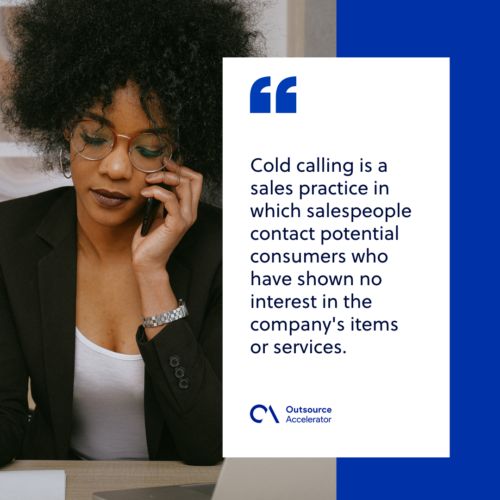10 cold calling strategies to help you close more deals

Cold calling has evolved through the years in the business world. From a method of reading a sales pitch, salespeople now apply various cold calling strategies to increase their success rate.
Nobody enjoys being forced to engage in a conversation they weren’t expecting to have. Some people even regard cold calling as a violation of a prospect’s privacy. However, for some reason, cold calling strategies continue to be effective at increasing sales.
What does cold calling mean?
Cold calling is a sales practice in which salespeople contact potential consumers who have shown no interest in the company’s items or services.
The term cold calling may also refer to soliciting a prospect via various channels without prior contact with the salesman.
Cold calling is most often linked with phone or telemarketing solicitation, but it may also refer to in-person contact.

How effective cold calling benefits a business
In the last 12 months, 69% of consumers answered a call from a new salesperson. Making phone calls to new connections is highly effective, according to 27% of marketers.
Based on unexpected cold calls, 75% of prospects from diverse industries have attended an event or planned a meeting.
10 tips and techniques for effective cold calling
Cold calling may be exhausting and difficult. It is your responsibility to warm up a potential consumer, whether in person or over the phone.
Here are a few cold-calling strategies to make the process go more smoothly.
1. Accept rejection
Acceptance of rejection is the first and most crucial step. Rejection is an inescapable part of the sales process, from prospecting to closing, inbound and outbound. Nobody ever completes all of their goal transactions.
Don’t disregard a rejection. In addition, don’t force your pitch since you’ll come out as needy, which is a negative indication! Maintain a neutral tone and acknowledge the situation. It’s a situation in which you can still get a lot of knowledge.
2. Research
You may provide conversations with value and hold their attention by tracking down essential facts about them. Do your homework and show interest in the person on the other end of the line.
Your prospects will appreciate the extra work put in with personalization and will be more open to having a more in-depth chat with you.
3. Create an outline or draft
Make a concise cold call script that you may refer to while on the phone. The goal is to utilize this as a guide to help you deliver your message clearly and confidently, not to read it literally.
4. Compose a compelling first statement
You have ten seconds to show that you’re worth chatting with, so make sure to stand out from a sea of cold callers. After introducing yourself, personalize the conversation by weaving in your research and focusing on your prospect.
5. Avoid wasting time
You’re wasting their time if you contact someone who doesn’t meet your criteria. When you call someone who could benefit from your offer, you are assisting them in improving their lives and businesses. Don’t waste your time reaching out to customers who aren’t interested in what you’re selling.
Make sure you’re only adding businesses and contacts to your prospect list that you think you’ll be able to assist.
6. Make a call schedule.
Consider the best hour when you’re most likely to make a call and concentrate your efforts on interacting with the best prospects during those hours. Other times can be spent planning, preparing, writing different sequences, and fine-tuning your script.

7. Provide options
Give them options to help them cope with rejection. It might work if they realize you’re serious and have come prepared.
Letting your customer choose among two alternatives helps improve sales by giving them a sense of power.
8. Take the appropriate next steps.
On a cold call, you’re not going to complete a transaction. However, you must submit a request. Set clear next steps so that both you and the prospect are on the same page.
Getting your prospects’ agreement on their following actions and allowing them to change and provide feedback early on can significantly impact the deal flow.
9. Leave effective voicemails
Choose a method for capturing the prospect’s interest in the voicemail message. Remember, the goal is to stimulate the consumer’s interest enough to call you back – and not to start selling in your message.
Determine what you want the prospect to take away from your message. You may avoid leaving rambling, extended voicemails by limiting yourself to just one note.
10. Leave an open-ended question.
You want to discover as much as you can about your customer, what they do, and what they need via cold phoning. By inquiring about their feelings, you provide more opportunities for discussion.







 Independent
Independent




